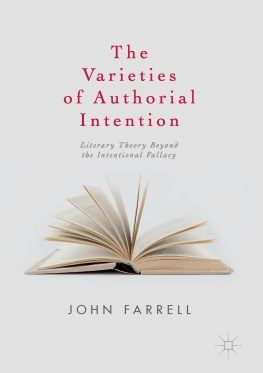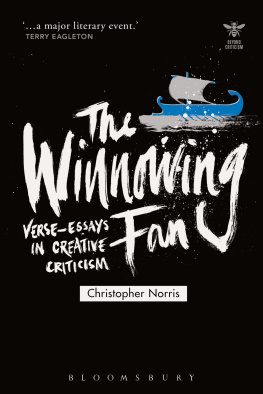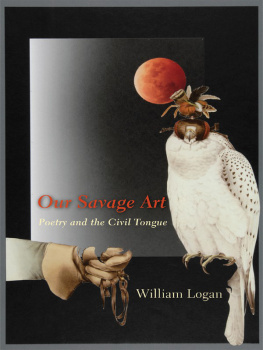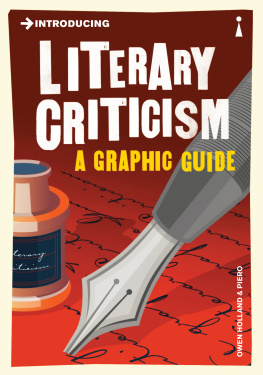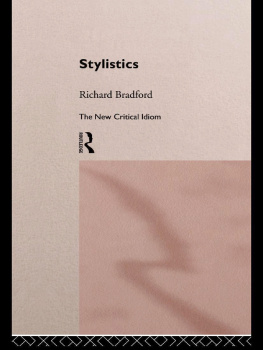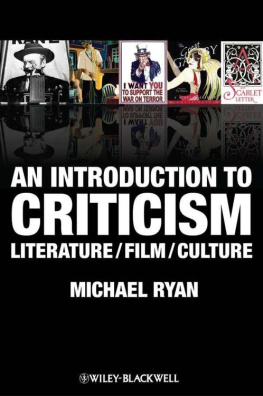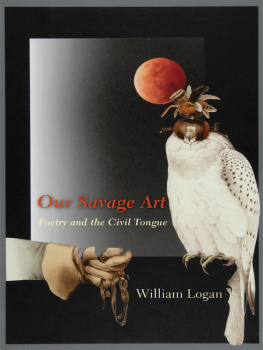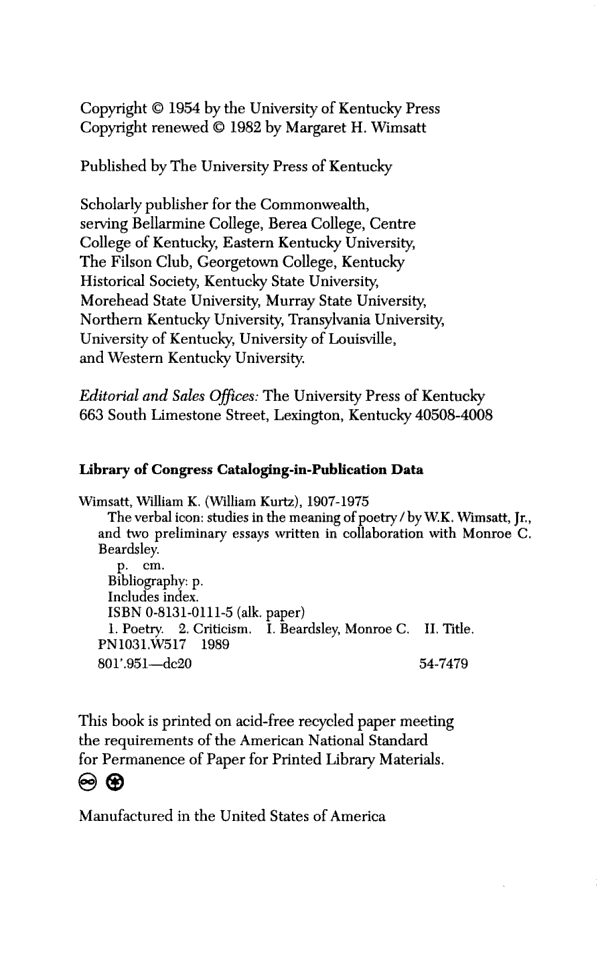THE VERBAL ICON
Studies In The Meaning Of Poetry
W.K. WIMSATT
and two preliminary essays written in collaboration with
MONROE C. BEARDSLEY
THE UNIVERSITY PRESS OF KENTUCKY
For M. H. W. and E. L. B.
ACKNO WLEDGMENT
I OWE a great deal to numerous friends who have read my manuscript drafts, given me advice, discussed critical problems with me, and in various ways promoted the writing of these essays. Especially I acknowledge a debt to Monroe Beardsley, who joined me in writing two of the essays, and who for a period of several years engaged me in an almost unbroken conversation which is one of my finest memorial possessions. I owe a special debt also to my colleagues Cleanth Brooks, Maynard Mack, and Ren Wellek; to Philip Daghlian and Robert Daniel; and to my wife.
My colleague Theodore Greene had a good deal to do with prompting the observations that occur in the essay entitled "The Domain of Literary Criticism." He was my opponent in a joint presentation of papers at the Stanford Modern Language Meeting in 1949. His answer to me entitled "The Scope of Aesthetics" should be consulted in the Journal of Aesthetics and Art Criticism, VIII, June, 1950.
Eight of these essays, or drafts approaching them, were read before learned societies and clubs. Some were written specifically for the occasions. I am grateful to all the audiences and all the chairmen. Let me name the English Institute, the Modern Language Association of America, the American Society for Aesthetics, the Catholic Poetry Society of America, the Faculty Seminar in English at Indiana University, the Silliman College Workshop Talks, the Philosophy Club and the English Club at Yale.
The essays have appeared in the following places: "The Intentional Fallacy," "The Affective Fallacy," and "The Substantive Level" in the Sewanee Review, LIV, Summer, 1946; LVII, Winter, 1949; LIX, Autumn, 1951; "The Concrete Universal," "Verbal Style: Logical and Counterlogical," and "History and Criticism" in PMLA, LXII, March, 1947; LXV, March, 1950; LXVI, February, 1951; "Poetry and Morals: A Relation Reargued" and "Poetry and Christian Thinking" in Thought, XXIII, June, 1948, and XXVI, Summer, 1951; "Rhetoric and Poems: Alexander Pope" and "Explication as Criticism" in English Institute Essays 1948 and 1951 (Columbia University Press, 1949 and 1952); "The Chicago Critics" in Comparative Literature, V, Winter, 1953; "The Structure of Romantic Nature Imagery" in The Age of Johnson, Essays Presented to Chauncey Brewster Tinker (Yale University Press, 1949); "Symbol and Metaphor" in the Review of Metaphysics, IV, December, 1950; "One Relation of Rhyme to Reason" in Modern Language Quarterly, V, September, 1944; "When is Variation 'Elegant'?" in College English, III, January, 1942; "The Domain of Criticism" in the Journal of Aesthetics and Art Criticism, VIII, June, 1950.
I wish to thank the editors of the magazines and the directors of the presses for their courtesy in extending permission for the republication of these materials.
The essays have all been revised, some of them extensively. "The Concrete Universal," "Poetry and Morals," "One Relation of Rhyme to Reason," and other essays to a less extent, have lost bibliographical footnotes, for which the reader having that kind of purpose is referred to the places of original publication.
W. K. W., Jr.
Silliman College
Yale University
September 4, 1953
A NOTE ON THE TITLE OF THIS BOOK: The term icon is used today by semeiotic writers to refer to a verbal sign which somehow shares the properties of, or resembles, the objects which it denotes. The same term in its more usual meaning refers to a visual image and especially to one which is a religious sym bol. The verbal image which most fully realizes its verbal capacities is that which is not merely a bright picture (in the usual modern meaning of the term image) but also an interpretation of reality in its meta phoric and symbolic dimensions. Thus: The Verbal Icon.
INTRODUCTION
THE ESSAYS which compose this volume were written over a period of about eleven years, from 1941 to 1952. They arose out of several critical preoccupations and occasions, and largely without my planning that they should ever be put together to make a book. They represent, however, what I believe has been my consistent approach to the literary problem at various levels. In the sequence which I now give them, not that of their original publication, and after revisions aimed at the improvement of their relations to one another, I believe the essays approximate a rounded whole.
The volume begins with three negatives. First, two essays which my friend Monroe Beardsley and I wrote to expose as fallacies two very prevalent approaches to the critical object, that by way of its origins in the mind of its maker, and that by way of its results in the mind of its audience. And thirdly, my single-handed objections to a kind of neo-Aristotelianism expounded by a group of critics at Chicago, a critical approach which, as it happens, has some close relations with the "fallacies."
The next four essays attempt to face some of the more substantive responsibilities of the critic who, eschewing the psychologistic kinds of escape, is willing to defend literature as a form of knowledge. What kind of meaning does literature have? How far is this explained by certain concepts, especially the concepts of metaphor and symbol? And what is the relation of literary value to other values involved in verbal structures, especially to moral values?
The next five essays deal with various problems of verbal style, attempting to treat these to some extent by a logic of parallels and oppositions and in general to demonstrate that style is a level of meaning. The proportion of attention given to these matters reflects not any view of mine about the correct center of literary studies but simply one of my chief interests and most frequent lines of access to literary inquiry. The essay entitled "Rhetoric and Poems" includes an introductory section devoted to sorting out several of the main relations which literary scholars develop, often confusedly, between the literary theory and the literary practice of given historical periods.
The concluding group of four essays returns to broader bearings, the relation of literature to other arts and of literary criticism to general aesthetics, the relation of literary meaning (so far as it may be neutrally considered) to literary value and to more general concepts of value and disvalue, the relation of evaluative criticism to historical studies, and the relation of literature not only to morals, as in the fifth essay, but more broadly to the whole complex of the Christian religious tradition.
II
The theory of verbal meaning on which these essays are written might here and there be mistaken for, but is not actually, a form of monistic expressionism. I believe in the integration of literary meaning but at the same time in different kinds and levels of meaning. It is surely true that in a certain sense no two different words or different phrases ever mean fully the same. That is the literary sense. But there are other senses, the abstractive senses of science, philosophy, practical affairs, and religious dogma, in which different formulations can and do mean the same. The bungled phrase, the slipshod paragraph, the inept metaphor, the irrelevant excursion, the disproportionate development, the feeble conclusion, are indeed all failures of meaning, and the more poetically ambitious the verbal structure in which they occur, the deeper and more substantive the failure may be. In a writing of any complexity, either poetic or philosophic, a confusion of style is likely to be part of a confusion at a more substantive level. On the other hand, stylistic meanings in more prosaic and abstractive structures are almost always capable of being looked on merely as adjuncts to a literal or message meaning. The message can remain the same while changes in the other meanings occur. One improves the style or the organization of a paper written by a student or a friend, but without necessarily making any contribution to his message. The reason such a change may be an improvement, or may be the opposite, lies in the interdependence of levels of meaning. The reason is always a matter of meaning, though it may lie at highly formal and implicit levels. I have refined this distinction as far as I was able in the essay on "Verbal Style" and in particular have tried to show what may be meant by a level of purely verbal style.


